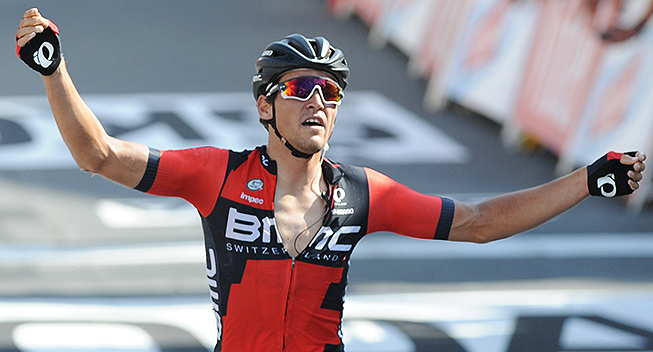The spring and autumn are dominated by the classics while the middle of the season is loaded with big stage races. Those two different kinds of races come together in the Dutch/Belgian stage race Eneco Tour which combines a number of stages in well-known classics terrain with a couple of sprint stages and a time trial to form a race for the one-day and time trial specialists. Having initially been criticized for its less exciting and sprint-heavy courses, the race has now found its format and is one of the major targets for some of the riders that usually dominate the spring.
Racing in Belgium is loaded with history but the emphasis has always been placed on one-day races and the country's many esteemed classics. Held for the first time in 1908, the Tour of Belgium has struggled to gain the popularity that national tours have had in the southern part of Europe and stage racing has mostly been neglected in one of cycling's most important areas.
When the ProTour was introduced in 2005, the well-established Tour of the Netherlands was deemed too easy to make it onto the sport's finest calendar and so the organizers sought help from the Tour of Belgium and the Tour of Luxembourg in an attempt to create a Tour of Benelux that could be included in the newly-founded race series. The cooperation with the Luxembourgish organizers never materialized but the Belgians and Dutchmen found together in a collaboration that allowed the Dutch tour to develop into a two-country race that made it onto the ProTour calendar. Suddenly, the Belgians not only had classics but also a stage race in the highest echelon.
During its first years, the race had difficulty finding its right format and many criticized the courses for being too easy and the event for having too many stages for the sprinters. Often the race was loaded with bunch sprints and only a single hilly stage and the crucial time trial decided the GC. The Dutch and Belgian geographies mean that the race will always have numerous opportunities for the fast finishers but the organizers have since toughened up the race by including more stages in the hard classics terrain and the race has now found its right mix between sprint stages and more difficult days for the one-day specialists.
What makes the race exciting is that it takes the riders back onto the roads that have been the scene of some dramatic racing in the spring season but that are rarely used in the second part of the season. Usually the event has a stage that includes many of the Flemish hellingen that characterize the Tour of Flanders, a stage held in the hilly Limburg province that hosts the Amstel Gold Race and a stage in the Wallonian Ardennes that are the scene of Fleche Wallonne and Liege-Bastogne-Liege. Those classics stages are combined with a number of days for the sprinters and a time trial to form a race for the versatile riders and classics and time trial specialists. As usual, the weather plays a crucial role in this part of the world and there is always the preeminent danger of crosswinds that can blow the race to pieces.
Despite the more difficult stages, the terrain is not hard enough to produce big time gaps and bonus seconds often play a crucial role. The most decisive stage is always the rather short time trial. No one will win the Eneco Tour without having the ability to race against the clock and the winners' list is a testament to that. The inaugural edition was taken by Bobby Julich and since then Stefan Schumacher, Jose Ivan Gutierrez (twice), Edvald Boasson Hagen (twice), Tony Martin and Lars Boom have all won the event. However, with a tougher course, the door is now open for more versatile riders as well and during the last two years the race had its first winners which are not known as real specialists as Zdenek Stybar and Tim Wellens have used strong rides in the hills to take the victory. The overall winner is usually a versatile rider that can stay in contention on the hills, manage the battle for position and the crosswinds, potentially pick up a couple of bonus seconds in some sprints and finish it off with a high-level time trial.
Due to its scheduling close to the Vuelta, one might expect the race to be a perfect preparation for the Spanish grand tour but the race has never developed into such a warm-up race. The kind of racing on offer is not very similar to the one found in the mountainous Spanish race and most riders prefer to improve their condition in the hilly Vuelta a Burgos or Tour de l'Ain rather than on the flat roads in Belgium and the Netherlands. For the sprinters, it is of course different and many of the fast finishers use the race to get their fast legs going ahead of the three-week race in Spain. On the other hand, the Vuelta has had very few opportunities for the sprinters in the three latest editions and so many of the fast riders avoid the Spanish grand tour.
Instead, the Eneco Tour has evolved into a major target in its own right. For the time trial specialists, it represents a rare chance to pick up some WorldTour points without having to overcome enormous mountains while the classics riders relish the chance to race in their preferred terrain at a time when those opportunities are limited. With the growing importance of points, more and more teams see the Eneco Tour as a great opportunity to increase their tally in a race that is not overly difficult.
This year the race has been given an extra twist with the inclusion of the concept of a golden kilometre. It made its debut at the Tour of Belgium this year and the Eneco Tour organizers liked the idea which they have adopted. In every road stage, there will be three intermediate sprints within just a single kilometre where the riders can score a total of 9 bonus seconds as there are 3, 2 and 1 second on offer for the first three riders across the line in each sprint. In addition to the golden kilometre, there will be 10, 6 and 4 bonus seconds on offer at the finish.
While the race attracts lots of classics specialists, it is also a big target for the sprinters and the event usually fields one of the strongest line-ups of fast finishers. This year is no exception as André Greipel, Giacomo Nizzolo, Sacha Modolo, Andrea Guardini, Jonas Van Genechten, Arnaud Demare, Moreno Hofland, Tom Boonen, Elia Viviani, Edward, Theuns, Roy Jans, Nikias Arndt and Magnus Cort are just dome of the riders that are ready to battle it out in the flat stages.
Last year Tim Wellens took a breakthrough overall victory after a memorable edition that provided lots of excitement. Having won the second stage, defending champion Zdenek Stybar was in a great position to go for the double when he crashed out of the race and instead it was Lars Boom and Tom Dumoulin who put themselves in pole position after the latter had come back from an unfortunate time loss in a flat stage to win the time trial. After Greg Van Avermaet had won the stage in the Flemish Ardennes, it was Wellens who surprised the favourites and exploited Dumoulin’s lack of team support to take a solo win on the queen stage in the Ardennes and he defended his lead on the final day. Boom and Dumoulin completed the podium. Wellens will be back to defend his title as he aims to make amends for a disappointing Tour de France debut while Boom will also be back in an attempt to take a second title in the event. However, there will be no Dumoulin at the start as the Dutchman is still recovering from the crash that ended his Tour de France prematurely.
The course
As said, the Eneco Tour is usually a race for classics riders that can time trial. However, while the first editions of the race clearly favoured the time triallists, the most recent editions have been a lot harder and the classics riders have had a bigger chance, culminating with Zdenek Stybar’s and Tim Wellens’ victories in the two latest editions of the race.
This year the organizers have again designed a classic course that is made up of a number of flat stages, a time trial and a few “classics”. In fact, the race will follow the exact same format that it has had since 2013 and it is only the exact design of the stages and their order that seem to vary a bit.
However, it seems that time trialling will be slightly more important than it has been in recent years. As it has been the case for a few years, the race will be made up of three flat stages, a time trial, a mini Amstel Gold Race, a mini Liege-Bastogne-Liege and a mini Tour of Flanders. While the Amstel stage is similar to the one used last year and is unlikely to create major differences and the finale of the Tour of Flanders stage is unchanged, the Liege stage has been made significantly easier and the uphill finish on the Cote de la Redoute has been abandoned. Furthermore, the time trial is longer than the only 9.6km test that was an unusually short affair in last year’s edition of the race. This means that it will be easier to create bigger gaps in the TT and it will be harder to make big differences in the hills. However, the time trial still comes early in the race and as the three hilly stages are gathered in the final half, the classics riders know exactly how much time they need to take back.
This year’s course may be split into two parts. The first four stages are completely flat and include three days for the sprinters and the 14km time trial. Unless the wind plays a role or crashes and technical finales create splits, the only time differences will be made in the individual discipline and by virtue of time bonus. The race comes to a very exciting conclusion with three “classics” in the final three stages, starting with an Amstel Gold Race which is followed by a Liege-Bastogne-Liege and a Tour of Flanders as the latter stage is back in its usual position as the decisive stage.
Stage 1:
Since the organizers decided to abandon the idea of an opening prologue in 2012, the Eneco Tour has usually started with a flat stage for the sprinters. 2014 will be no exception and for the second year in a row it will be the Netherlands that sends off the peloton. Like last year it will again be the windy area near the North Sea that is the scene of the opening ride and there is little doubt that the organizers hope for some tough conditions for the opener.
The riders will start their race in Bolsward in the completely flat part of the country where they will do a 183.5km circuit race around the city. It can be divided into three parts. First the riders will tackle a 45.7km circuit on the northern outskirts of the main city. Like the rest of the stage, it is completely flat and doesn’t include too many technical challenges but it ends with a short ride along the coast before the riders turn inland to head back to the start-finish area. Then the riders will do a lap of a much longer 97.4km circuit on the southern outskirts and it is pretty similar to the opening challenge both when it comes to technical challenges and terrain. There will be Primus sprints at the 57.3km and 139.1km where there will be points on offer for the sprints classification. Again the final part takes places close to the coast which should make things pretty nervous if the conditions are right.
The riders will cross the finish line again after 143.1km of racing and the riders will now end the stage by doing two laps of a 20.2km circuit around Bolsward. It doesn’t offer any real technical challenges and as it is also completely flat, only the wind and crashes can do some damage. The golden kilometre starts with 23.2km to go when the riders approach the end of the first lap. The finale is very easy as the riders will take the final left-hand turn with 4.6km to go and then they will follow a long, straight, flat road all the way to the finish.
Usually, it is not too windy in the summer and so this stage is most likely to be a straightforward sprint stage where the fast guys will get the chance to go for the first leader’s jersey. However, there is always the risk of splits in the crosswinds and if there is just a small danger, we should get some nervous racing that could potentially split the field. However, the most likely outcome is a big bunch sprint and with lots of sprinters at the start, there will be plenty of teams to do the chase work. Unlike most of the Eneco Tour finales, this one is very easy which means that the technical challenges are unlikely to create any gaps between the overall contenders who will be looking to the golden kilometre as their best chance to potentially gain some time on the opening day.
Bolsward has not hosted the finish of a major bike race for more than a decade. Last year it was Andrea Guardini who won the opening sprint stage while Mark Renshaw surprised the sprinters by attacking in a late turn to take the first yellow jersey two years ago.
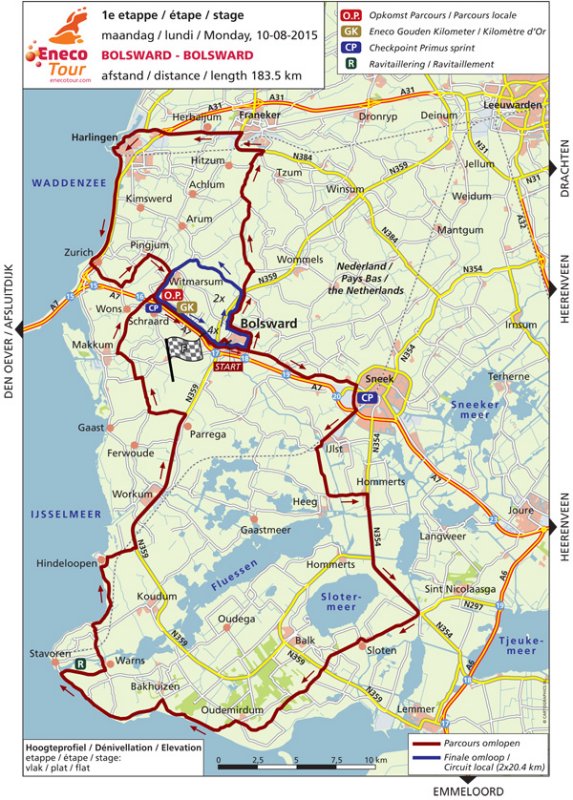
Stage 2:
The sprinters that missed out on the opening day, will get an immediate chance to take their revenge as the race continues with another completely flat stage in the Netherlands. Overnight the riders have done a long travel to the southern part of the country and are a bit farther away from the coast but they are still in a part of the country that can be pretty windy.
At 180.7km, the second stage is another circuit race and this time it is the bigger city of Breda that plays host to both the start and the finish. The design of the stage is pretty similar to the opening test as it can again be split into three parts. First the riders will do a lap of a flat, non-technical 25.7km circuit on the southern outskirts of the city before they get back to the start-finish area. Then they will take on the main circuit which is 95.6km long and covers the area on the western outskirts of the city. Again the terrain is flat and it will be the many traffic islands that will offer the technical challenges. The first Primus sprint comes at the 72.6km mark and later the riders will do a few kilometres on Belgian soil before they return to the Netherlands for the final part of the stage.
The riders will cross the finish line after 121.3km of racing and then the final part of the stage consists of two laps of a 29.7km finishing circuit. Apart from the final part which takes place in the city, it is not very technical and it is completely flat. The second Primus sprint comes near the end of the first lap with 35.5km to go while the golden kilometre starts with 21.5km to go when the riders have covered the first part of the second lap. Again the organizers have spared the riders from the usual technical finale as the riders will take the final left-hand turn with 2.1km to go and from there the road only bends slightly to the left.
With lots of sprinters at the start, it is hard to imagine that they will miss the opportunity to go for glory in another completely flat stage that is tailor-made for them. Again the biggest danger is the wind but history proves that the conditions at this time of the year are rarely harsh enough to split the field. In the last few years, we have had time gaps between the overall contenders in the flat stages as technical finales have created splits but this stage has a pretty easy finale. This means that it should be a perfect day for the real power sprinters to go for glory for the second day in a row.
Breda hosted a stage for the first time in 2014 when Tom Dumoulin took the time trial victory in the Dutch city. One year earlier it played host to the first stage of the Ster ZLM Toer where Theo Bos powered to one of the biggest wins of his career by beating the sprinting titans of Marcel Kittel, André Greipel and Mark Cavendish.
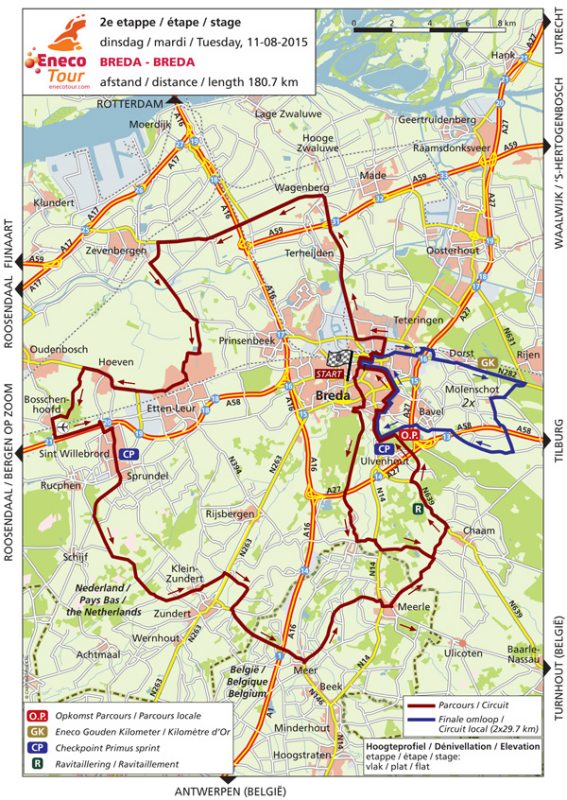
Stage 3:
The first three days will be all about survival for the GC riders who have to stay attentive due to the risk of splits but have to wait for the second half to show their cards. Meanwhile, the fast riders have to make the most of the first three stages which are their only chances to go for glory in the Dutch-Belgian race.
After two days in the Netherlands, the race is in Belgium for the third stage which brings the riders to the traditional finish in Ardooie which has become a fixture in the WorldTour race. For the first time in this year’s edition, the stage is not a circuit race as it covers 171.9km from Beveren to the city in the southwestern part of the country. Again it can be split into three parts, with the big difference that the middle part is not a circuit on the third day.
As it is often the case in the Eneco Tour, the riders will first do a lap of a circuit around the starting city. The opening circuit is 17.1km long and brings the riders through the flat terrain on the southwestern outskirts of Beveren. The first Primus sprint comes near the end of the circuit after 16.6km of racing.
The second part of the stage consists of a long southwesterly journey from Beveren to Ardooie and again the terrain is completely flat. There will be no sprints along the way and the roads will be completely flat. With 42.7km to go, the riders will reach the finishing circuit and then they will do almost a full lap before the get to the finish for the first time. Before they get there, they will do the final Primus sprint when 33.8km remain.
Moments later, the riders will cross the finish line to start the first of two laps of the 15.4km circuit. It is the same circuit that was used for the fourth stage of last year’s race and the opening stage of the 2013 edition of the race. It is completely flat and has a pretty technical final part with lots of traffic islands. With 1.4km to go, the riders do three sharp turns in quick succession before they hit the 1.1km finishing straight. The golden kilometre starts with 24.9km to go at the midpoint of the first lap.
As the terrain is completely flat and is the final chance for the sprinters, this stage is destined to end in a bunch sprint. The only potential danger is the wind and the crashes but there won’t be too many changes of direction which means that we are unlikely to get a big drama. However, the GC riders have to stay attentive in the technical finale where splits can occur and this will make the final part very nervous.
Ardooie has hosted a stage finish every year since 2008. Tom Boonen was the first rider to win a bunch sprint while Tyler Farrar took the win one year later. In 2010, André Greipel was the fastest rider and he repeated the feat in 2011. In 2012, the city hosted the time trial which was won by Svein Tuft while Belkin used the late turns to open a gap behind their lead-out man Mark Renshaw in 2013, with the Australian holding off the sprinters all the way to the line. Last year Nacer Bouhanni won a bunch sprint but the stage is mostly remembered for the dramatic finale that saw defending champion Zdenek Stybar crash out of the race on the finishing straight.
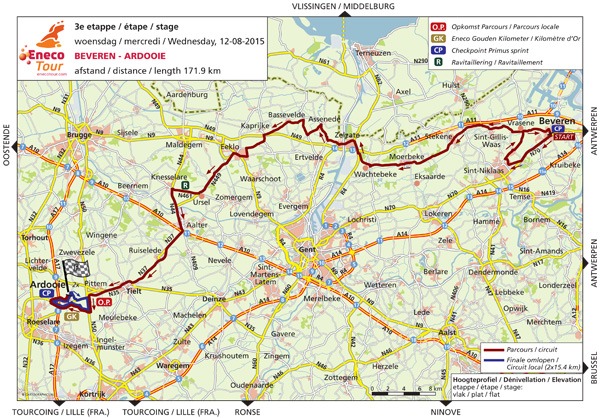
Stage 4:
Time trialling has always been a key part of the Eneco Tour and of course it will be no different in 2015. The TT has often been the single most decisive stage and with an easier queen stage, it will be even more important in 2015 than it has been in 2013 and 2014. Furthermore, the stage is longer than it was 12 month ago and with plenty of flat, straight roads, it should offer lots of terrain for the specialists to make a difference.
This year the time trial comes on the fourth day and after a day in Belgium, the riders are back in the Netherlands for the individual test. This year the city of Hoogerheide which is well-known as a key venue in cyclo-cross, will play host to the stage that covers a distance of 14km on the southern outskirts of the city. The circuit is almost rectangular and is mostly made up of straight road with only a few corners to break the rhythm, mainly in the final part when the riders are back in the city.
In 2013, the time trial was pretty hilly while last year’s stage was completely flat. This year it is again a predominantly flat ride. The first 1.5km are mainly descending while the final three kilometres are gradually ascending but the riders will stay between 0m and 25m above sea level, meaning that the stage profile looks harder than it is. In the finale, the riders will turn right just after a roundabout and then turn right in another roundabout before they take two turns in quick succession to get onto the 100m finishing straight.
The profile of the stage is not completely flat but as the climbing is pretty easy and most of the stage is made of up of long, flat, straight roads, this is a day for the biggest specialists. In such a short time trial, the time gaps are never very big but as the Eneco Tour is usually decided by seconds, the time gains here will be hugely important in deciding the overall winner of the race. This is the day for the TT specialists to make the difference while the classics riders hope to limit their losses before they get into the hills for the final three days of the race.
Hoogerheide has often hosted major cyclo-cross races including the World Championships, but it has rarely been used for road racing. In fact, it has not been the scene of the finish of a major race for more than a decade.
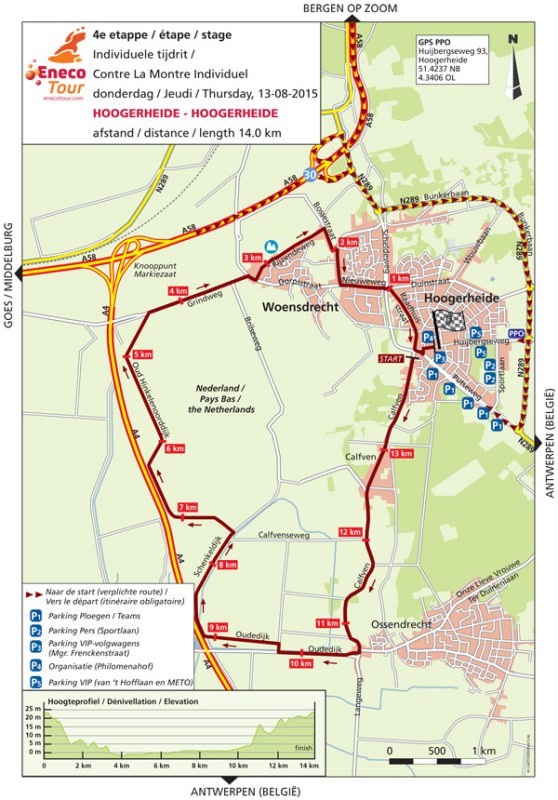
Stage 5:
After a few nervous days and a time trial, it is time for the classics riders to start to take back the time that they have lost in the race against the clock. They will get their first chance in stage 5 which is like a mini Amstel Gold Race. Every year the race hosts a small version of the Dutch classic in the Limburg province and this year it will be no different. Last year the Amstel stage was held on the final day but this year the progression in the difficulty is more natural as the stage comes as the first test in the hills. This year’s stage is very similar to the one that featured one year ago and includes no less than 23 climbs but history proves that the terrain is rarely hard enough to create any differences between the best riders.
Like last year, the 179.6km stage starts in the Belgian city of Riemst and finishes in the Dutch city of Sitaard-Geelen in the heart of the Limburg province. The stage is almost identical to the one that was used in 2014 as the only change is the omission of a flat part of the finishing circuit which has been shortened slightly. It includes a total of 18 climbs and ss many of them feature multiple times, the total number of ascents is no less than 23. The start of the stage is the easiest as the riders first do a lap of a circuit around Riemst that only includes the Muizenberg (650m, 6.6%). The first Primus sprint comes already after 13.3km of racing.
From there, the riders travel in a westerly direction and go up the Cote Halembaye (1100m, 6.6%) just before they cross the border after 34.2km of racing. That marks the start of the climbing hostilities as the riders now tackle the Heiweg (1400m, 4.0%), Bergenhuizen (500m, 8.0%), Hoogcruts (700m, 5.0%), Loorberg (1400m, 5.3%), Camerig (1300m, 5.4%), Schuttebergsweg (1200m, 5.3%), Mamelisserweg (600m, 5.8%), Gulperberg (450m, 9.3%), Wittemerweg (800m, 4.9%), Eyserbosweg (1050m, 8.2%), Oude Huls (600m, 7.5%), Schanternelsweg (1000m, 6.0%) and Fromberg (1100m, 5.9%) in quick succession with very little room for recovery in between. Many of those climbs are well-known by most of the riders from the Amstel Gold Race where especially the Eyserbosweg stands out as one of the hardest challenges. However, it comes a bit too early to make a big difference in this stage. Along the way, the riders have turned to the north and are now heading towards the finish in Sittard-Geelen.
After the Fromberg, there is a short, flatter section that precedes the finale which kicks off with the Bergstraat (1000m, 7.0%) with 54.3km to go. Just after the top, the riders reach the finishing circuit and moments later they tackle the Windraak (700m, 4.5%) before they cross the finish line for the first time.
The final part of the stage is made up of two laps of a 22.4km finishing circuit that includes six climbs in quick succession. The Kollenberg (400m, 5.0%) comes 19.8km from the finish and there is unnamed ascent (300m, 6.5%) 2.8km further up the road. With 15.9km to go, the riders tackle the Sittarderweg (800m, 4.0%) while the Schatsberg (800m, 5.0%) comes 14.2km from the finish. There’s another unnamed climb (350m, 8.0%) 8.7km from the line while the Windraak is the final challenge with just 4.4km to go. The final Primus sprint comes just 4km from the finish while golden kilometre starts with 35.6km when the riders hit the Schatsberg on the first lap.
After the Windraak, there is a short descent and then the final part of the stage is flat. It’s pretty technical as the riders do four turns between the 2.1km and 1.5km to go marks. Then a straight road leads to the final left-hand turn that comes just 400m from the line. Compared to last year, the circuit is a bit shorter as a flat part in the beginning has been removed but the finale and the main challenges are unchanged.
The stage offers lots of climbs but the hardest ones come pretty far from the finish. The ascents on the finishing circuit are pretty easy and many sprinters will be able to survive them. Last year’s stage proved that it was hard for the GC riders to make a difference and even though they will definitely test each other, they will be keen to keep their powder dry for the sterner tests in the weekend. Last year it was a breakaway that made it to the finish but this year the stage comes at a time when the time gaps will be much smaller. This means that the GC teams are unlikely to allow the situation to get out of control and so the most likely outcome is a reduced bunch sprint in Sitaard-Geelen.
Sittard-Geelen is the only city to have hosted a stage finish in every edition of the race. In 2005, Simon Cadamuro won a bunch sprint while Manuel Quinziato narrowly held off the sprinters one year later when Cadamuro had to settle for second. In 2007, Sebastien Rosseler took a time trial win and Jose Ivan Gutierrez won the opening prologue in 2008. In 2009, Lars Bak held off a select group after a hard day in the Limburg province while Jack Bobridge was the strongest from a breakaway in 2010. In 2011, Edvald Boasson Hagen won a bunch sprint while Orica-GreenEDGE won the only team time trial in the history of the race in 2012. In 2013, the city hosted the time trial which was on by Sylvain Chavanel. Last year Guillaume Van Keirsbulck emerged as the strongest from a breakaway as he rode away for a solo victory. The GC riders tested each other in the finale but it was a 30-rider group that sprinted for 11th, with Greg Van Avermaet crossing the line first from the main group.
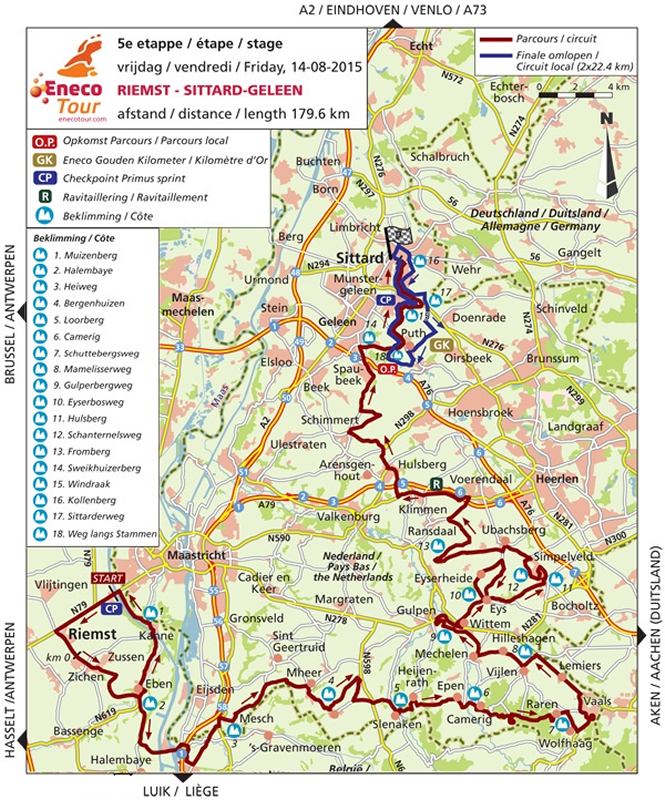
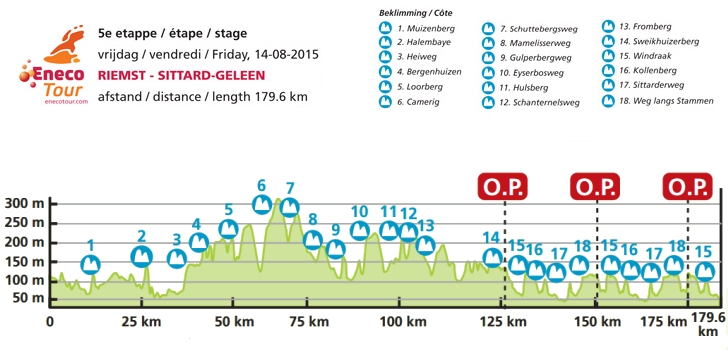
Stage 6:
The Eneco Tour has always included a hard stage in the Ardennes but in 2013 and 2014 the organizers made it tougher than ever. In a tribute to Liege-Bastogne-Liege and its famous climb Cote de la Redoute, they designed a stage with a very tough finishing circuit that ended atop the famous ascent. The stage provided some of the most exciting and dramatic racing in the history of the race but this year the toughest climbing stage has been changed. It still features some tough challenges and climbs known from the oldest classic but it does no longer include and uphill finish and the climbs are not as tough as they were in the previous editions. Again a key climb from Liege-Bastogne-Liege will play a key role as the finish is located at the bottom of the Cote de Saint-Roch but the riders will not go up the ascent in the end.
While the amount of climbing has been reduced, the distance has been increased as the riders will cover no less than 208.6km from the Dutch city of Heerlen to the Belgian city of Houffalize that is known from the world of mountain biking. However, the longer distance is mainly made up of easier terrain with just a few smaller climbs and the finishing circuit is easier than last year’s. The riders will tackle 10 small hills but as some of them feature multiple times, the total number of ascents is 15.
The first part of the stage is very similar to the opening of last year’s stage. The hostilities kick off right from the start as the first part of the stage consists of a small circuit around Heerlen that includes the Bergseweg (2200m, 4%). In fact, the official start is given on the climb and it features again after just 10.7km of racing when the riders have done a full lap of the circuit and have started a long southerly journey towards the Liege-Bastogne-Liege terrain.
Along the way, they go up the Mamelisserweg (500m, 6%), Rugweg (1900m, 4.2%) and Schuttebergsweg (1800m 5.3%) before the cross the border after 29.1km of racing. The riders will now deviate from last year’s course as they continue their southerly journey towards Houffalize. The first climb on Belgian soil is the Hochstrasse (800m, 4%) at the 44km mark and 10.7km later, the riders will tackle the long Malmedyerstrasse (3000m, 5%).
After the feed zone, the riders will tackle the tough Cote La Ferme Libert (1100m, 14%) at the 80.2km mark and then the Cote Bois de l’Abbaye (1100m, 5%) after 92km of racing. The Cote Wanneralval (3000m, 4%) comes just 3.4km later but then the riders get to the easiest part of the course where the terrain is significantly flatter.
The hostilities start again at the 126.8km mark when the riders go up a 2.3km climb that average 5%. 9.4km later they hit the Rau de Cowan (900m, 6%) before they get to the finish for the first time after 139.3km of racing.
They now tackle a small 15.1km circuit on the southern outskirts of Houffalize that includes the famous Cote Saint-Roch (1000m, 11%) - known from Liege-Bastogne-Liege – right after the passage of the line. At the 154.4km mark, they are back at the finish and then the final part of the race is made up of two laps of a 27.1km finishing circuit.
Of course it starts with another passage of the Cote de Saint-Roch before the riders descend to the bottom of the Rue Bois des Moines (1200m, 8%) which comes just 22.9km from the finish. 7.5km later it is time for the Cote Achouffe (800m, 8%) before the Cote Petit-Monfort (400m, 5%) looms as the final challenge 11.9km from the line. The final part of the stage includes undulating terrain and the final 1km is slightly uphill but there are no major climbs. In the finale, the riders will follow a winding road before they take a sharp right hand turn just 300m from the line. The golden kilometre starts after the Roue Bois des Moines on the final lap when 20.5km remain. The second Primus sprint comes at the top of the Cote de Saint-Roch on the first lap.
There is no doubt that this is the hardest stage of the race as the climbs are both longer and steeper than they are at any other point in the race and so it is the day that will create the biggest time gaps between the first and last rider. The first three climbs on the finishing circuit can do some damage and especially the Cote de Saint-Roch will be a big challenge. However, they all come relatively far from the finish and it won’t be easy for a single rider to do what Wellens did 12 months ago. To create bigger time gaps, the stage have to be made hard right from the beginning and if the main riders are isolated in the finale, a solo move or an attack from a small group has a chance. However, the most likely outcome is that a small group of GC contenders will sprint for the win in Houffalize.
The city of Houffalize is a major venue in the world of mountain biking but it has rarely been used in road racing. In recent years, it has hosted a stage finish of the Tour de Wallonie on three occasions. In 2011, Joost Van Leijen took a surprise win by beating race leader Greg Van Avermaet in a two-rider sprint. In 2005, Guido Trentin won the stage while it was Leif Hoste who came out on top in 2000.
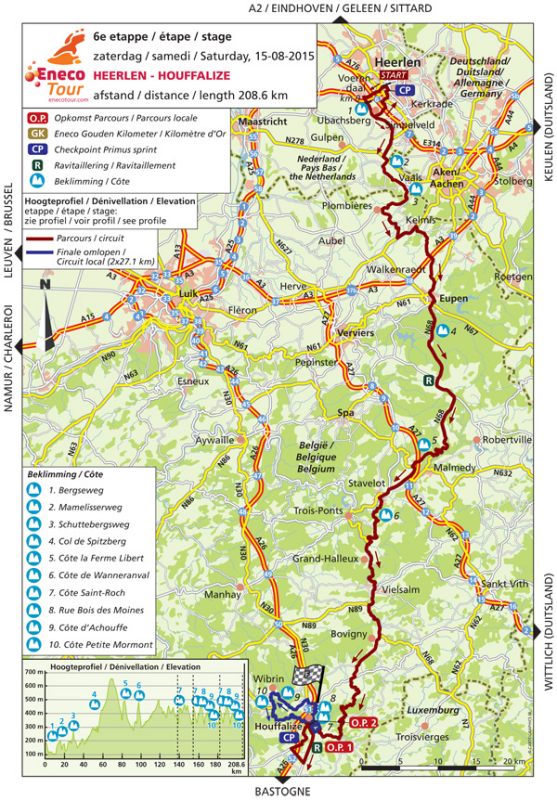
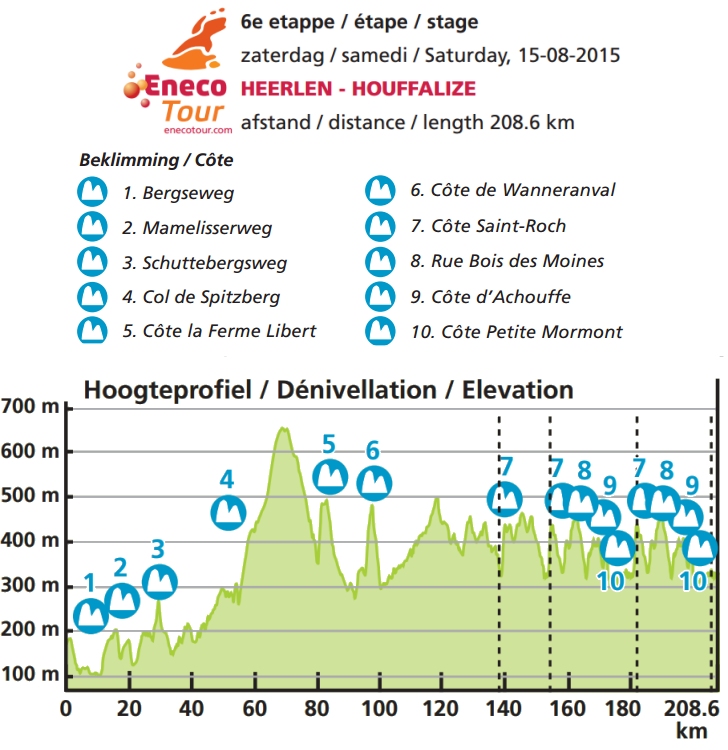
Stage 7:
Nothing will be decided until the final day of the race as the organizers have saved one of the two hardest stages for the very end. With the only uphill finish in the race, the final stage may even offer the best chance to create differences between the best riders after the time trial.
Naturally, the race has usually included a stage in the Flemish Ardennes but in 2012 the organizers decided to make it a lot harder by making it finish on the famous Muur van Geraardsbergen. When it was announced that the famous climb would no longer be part of the Tour of Flanders course, the city of Geraardsbergen made an agreement with the Eneco Tour which ensured that the stage race would include a stage on the wall in 2012, 2013 and 2014. In the first two years, the stage came on the final day but last year it was held before the mini-Liege and mini-Amstel stages.
This year it is back at the tail end of the race and the organizers haven’t changed much of what is now a classic in this race. At 188.6km, it is a bit longer than it was 12 months ago but it still doesn’t have the length of a classic. However, apart from the distance, it has all the ingredients of one of the major Flemish one-day races. The riders will tackle no less than 12 of the famous hellingen in the Flemish Ardennes and as they go up some of them multiple times, 17 climbs are spread throughout the entire course, three less than last year.
Unlike last year, the stage doesn’t start in Geraardsbergen. Instead, the riders will take off from Sient-Pieters-Leeuw on the outskirts of Brussels, meaning that the first part of the stage is relatively flat. A usual, the riders will first do a lap of a circuit around the starting city. This time it’s 12.6km long and completely flat. Having returned to the start, the riders will contest the first Primus sprint very early in the race.
The next part of the course is made up of a long westerly run towards the Flemish Ardennes. Already at the 25.1km mark, the riders will tackle the Pelikaanberg (500m, 4%) but apart from that small ascent, the roads are mainly flat. They will pass the city of Geraardsbergen to get into the Flemish Ardennes where the climbing gradually start with the Mont (2000, 4.7%) and Kanarieberg (1000m, 8%) at the 75.3km and 79.9km marks respectively.
Having reached the city of Ronse, the riders will turn right to head to Oudenaarde and from here the stage is almost identical to the one that was used 12 months ago. In Oudenaarde, they will climb the Edelareberg (1600m, 4%) with 93.9km to go. Then it’s time to turn around to head back to Geraardsbergen where the stage will be decided. This is when the real race starts as the riders will tackle Leberg (900m, 4%), Berendries (1000m, 7%), Valkenberg (800m, 6%) and Tenbosse (400m, 7%) with 84.8km, 80.4km, 74.9km and 68.5km to go respectively and with 59.7km to go, they will hit the finishing circuit.
The riders now do the tricky final 8.5km for the first time. First they tackle the Denderoordberg (700m, 8%) before they descend down to the bottom of the Muur (1100m, 8.7%). The finish line comes 600m up the climb and signal the start of the final two laps of the 25.6km finishing circuit. The second will be contested at the top of the Mur after the first passage.
The circuit a very tough affair with no less than 4 climbs. Having descended from the Muur, the riders go straight up the famous Bosberg (1000m, 6%) which is another climber no longer featuring on the Ronde course. It is followed by the easiest section of the circuit before the riders hit the Onkerzelestraat (1500m, 3%). At the top, there’s still 11.2km to go, with the first part made up of a descent before the riders again reach the final section with the Denderoordberg and the Muur whose first 600m lead directly to the finish at the end of the second lap. The riders do two right-hand turns just after the flamme rouge before heading onto the climb where there’s a left-hand turn just 200m from the line. The golden kilometre starts halfway up the Bosberg on the final lap when 20.8km still remain.
As said, the tricky finishing circuit has been used for the final stage of the 2012 and 2013 editions of the race and in stage 6 of last year’s race too and so it is now well-known by most of the riders. In the first edition, the peloton exploded to pieces on the Muur and in the end, Alessandro Ballan and Lars Boom emerged as the strongest. While the Italian took a rare victory on the famous Muur, the Dutchman gained enough time on then race leader Svein Tuft to win the race overall. In 2013, Zdenek Stybar took the jersey off Tom Dumoulin’s shoulders by finishing off a perfect display of team tactics. After Sylvain Chavanel had put the rivals under pressure, Stybar launched his own attack on the final lap to bridge the gap to lone escapee Ian Stannard. Accelerating hard from the bottom of the Muur, the Czech dropped his companion and soloed across the line to take both the stage and the overall victory. Last year it was Greg Van Avermaet who made the difference as he accelerated hard to fly past a fighting Pavel Brutt who had attacked a little earlier. He put one second into Tom Dumoulin, Brutt, Matti Breschel and Lars Boom which allowed Dumoulin to take the leader’s jersey off Boom’s shoulders by virtue of bonus seconds.
The stage may be held in classics terrain and have a pretty tough finale but due to the shorter distance, it is of course not as selective as the Tour of Flanders. In 2013, 31 riders finished within a minute of the stage winner while in 2012 47 riders managed to reduce their time loss to less than 60 seconds. Last year no less than 32 riders finished within 6 seconds of Van Avermaet while 41 riders limited their losses to less thana minute.
As in any classic, the weather will play a crucial role and team tactics will be equally important. It’s a day for the riders that excel in the cobbled classics and due to the finish on the Muur, punchy sprinting skills are of utmost importance. However, history shows that the time gains are pretty small if it all comes down to a final uphill sprint and so riders that have lost a bit of time in the time trial will have to make their moves a bit further out. As it is the final stage, there is no reason to hold anything back and so the race is likely to be more aggressive than it was 12 months ago. The classics riders will hope for bad weather and will try to make the race as hard as possible before making their moves on the final lap. Stybar and Boom have proved that it is possible to turn the GC around in this stage and nothing will be decided until the riders have sprinted up the Mur for the final time.
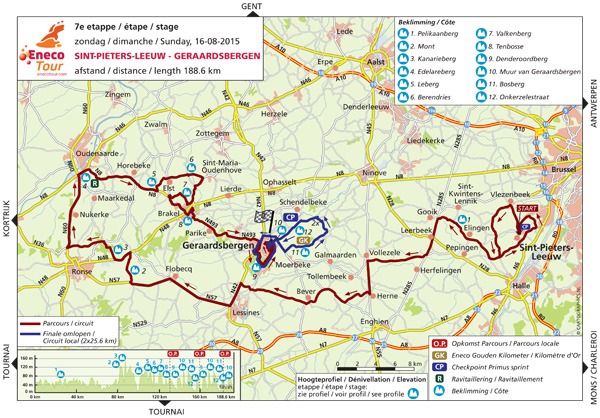
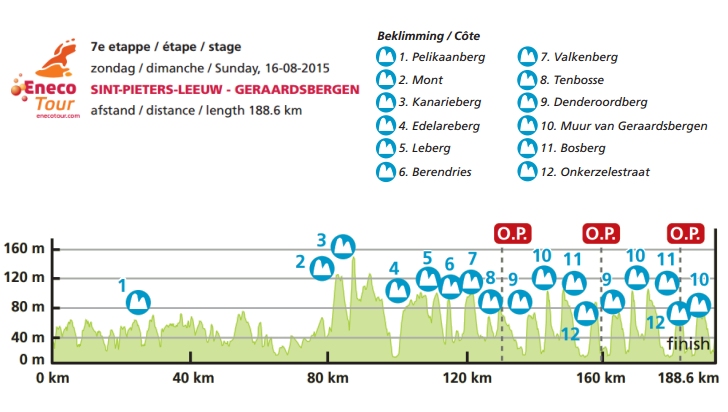
The favourites
Usually, the task of selecting the favourites for the Eneco Tour mostly consists of picking out the strongest time triallists and deleting those of them that are unable to handle the harder stages. Last year things were a bit more complicated as the amount of climbing was significantly harder which made it easier for the classics riders to make a difference and made team tactics a lot more important. That was evident in the queen stage where an isolated Tom Dumoulin was unable to control all attacks and this allowed Tim Wellens to ride away with the overall victory.
This year the queen stage is a lot easier and this should make it more suited to time triallists. This doesn’t mean that it will all come down to the TT though. In 2013, Zdenek Stybar managed to use a combination of climbing skills, explosive attacks and sprinting to open enough gaps and score enough bonus seconds to win the race. With three tough classics, the terrain is definitely there to try to make a difference and put the time triallists under pressure. Furthermore, the introduction of the golden kilometre will make bonus seconds a lot more important and it will be easier for the punchy guys to pick up bonifications.
On the other hand, no one can deny the time trial will be the most important stage. It is longer than last year’s stage and with long, flat straights it is perfectly suited to the specialists. With no uphill finish in the Ardennes, the queen stage will be more of an elimination race that will take heavier guys out of contention but where it will be hard for riders like Greg Van Avermaet and Philippe Gilbert to gain seconds – apart from bonifications of course. They will have their best chance to use their explosiveness in the final stage but history proves that it is hard to create big gaps in that stage. Finally, the stage in Limburg is probably not hard enough to make any difference.
However, team tactics can easily come into play. Last year Dumoulin was isolated in the Ardennes stage and this opened the door for Wellens to take the win. It is definitely possible that we will have a repeat of that scenario in the queen stage and so the race could again get a surprise winner. It won’t necessarily be the best time triallist or the best classics rider that will win the Eneco Tour.
Overall, the race suits a time triallist who can keep up with the best in the queen stage and limit the losses to the puncheurs in the final stage. For the classics riders, it will be about limiting the losses in the TT and then use their explosiveness to gain time in stage 7 and take bonus seconds in the final three stages. Finally, it will be important to have a strong team in the first part of the race where wind can play a role and be attentive in the tricky finales where splits have often been created.
Last year Greg Van Avermaet won the Flanders stage and finished fifth overall but it has always seemed like the overall win would be beyond his reach. The BMC rider has always been a pretty poor time triallist and his time losses in the race against the clock have been too big to be a real contender.
However, things seem to have changed in 2015. Van Avermaet has done some very good TTs this year. It all started when he was a surprise 9th in the Tour of Qatar TT and later he was third and 11th in the Tirreno TTs. He laid the foundations for his Tour of Belgium win with a fifth place in the prologue and he was sixth in the Tour de Suisse prologue.
Van Avermaet suffered a bit more in the Tour de France TT which was a bit longer and it is evident that the BMC rider still can’t handle the longer distances. The Eneco Tour TT is probably a bit too long for him and there is no chance that he will win the stage. However, unlike in previous years he should be able to limit his losses pretty well.
This puts him in a position to go for the overall win. In addition to his improved time trialling he has become a lot stronger on the climbs recently. His stage win in the Tour de France was hugely impressive and he even seemed to drop the best climbers in the world in the Clasica San Sebastian on a climb that should actually have been too hard for him. If he can handle that kind of challenge, he will be unstoppable on the climbs in the Ardennes and Flanders which suit him a lot better.
Furthermore, Van Avermaet is fast in a sprint and he will benefit a lot from the inclusion of the golden kilometre which he already used to his advantage in the Tour of Belgium. His fast sprint will make him one of the favourites in stages 5, 6 and 7 and this means that he can potentially pick up a lot of bonus seconds to erase his deficit from the time trial. Furthermore, he can probably create gaps in stage 7.
Finally, he can rely on the strongest team in the race. BMC go into the race with a formidable roster of classics riders. Philippe Gilbert will be the second captain and Loic Vliegen and maybe Daniel Oss should provide support deep into the Ardennes stage. With two potential winners, they will have an advantage in what can be a very tactical queen stage and they can be the ones to do what Wellens did last year. This year it seems that everything has fallen into place for Van Avermaet and so he is our favourite to win the race.
Interestingly, his biggest rival could be his own teammate. Philippe Gilbert has never won this race which suits him really well. On paper he is a better time triallist than Van Avermaet but he is not as strong as he was in 2011 when he was Belgian champion in the discipline. Furthermore, he is usually not quite as fast as Van Avermaet in a sprint and this could give his Flemish teammate the upper hand.
At the same time, Gilbert doesn’t seem to be at 100% yet after he had to skip the Tour due to a small fracture. He still won a stage in the Tour de Wallonie but he was unable to match Danny Van Poppel in the final stage which should have suited him down to the ground. He still managed to finish second in the Clasica San Sebastian but he was unable to stay with the best on the climbs, indicating that there is still room for improvement.
On the other hand, the condition is clearly growing and we can expect him to be a lot stronger in this race. He would definitely have preferred an uphill finish in the Ardennes but he still has the final stage to try to make a difference. He hasn’t done the Flemish classics for a few years but he has been on the podium in Flanders and so knows how to handle the cobbled ascents.
The main challenge will be to decide the internal hierarchy. Who’s going to do the intermediate sprints and the sprints at the end of the stages? Much will depend on the time trial where Gilbert probably hopes to gain time on Van Avermaet. However, it could all come down to race tactics in the queen stage where it will require a bit of luck to hit what could be a race-deciding move. In that scenario, Gilbert is on equal terms with his teammate.
Fabio Felline has had a breakthrough year in 2015. In the past, he has mostly been known as a strong sprinter but this year he has turned into one of the most versatile riders. He has done some amazing time trials, even beating his teammate Bob Jungels to win the Criterium International TT, and he climbed impressively to finish on the podium in that race. He won a stage in the Vuelta al Pais Vasco and he rode very aggressively in the Giro.
In the future, he has set his sights on the classics and they should really suit him well. This obviously makes him a contender for this race. If he can time trial in the way he did in Pais Vasco, the Giro and the Criterium International, he will be able to gain time on almost all his rivals in the TT. He is fast in a sprint and has the potential to score lots of bonus seconds and win some of the final three stages. He doesn’t have much experience on the cobbles and that could prove to be a challenge though.
The main question is his form. He didn’t really shine in the Tour de Wallonie where he also had bad luck to suffer a puncture in stage 3. However, he worked for van Poppel in the final stage and so the results may not be fully indicative of his form. If he is on fire like he was in the spring, there is a big chance that he will win this race.
Astana are not known as a classics team but they actually have three potential winners of this race. There best card is probably Andriy Grivko who simply loves this race. He was on the podium in 2013 and fourth in 2014. That is no coincidence as he has all the characteristics to do well here. As the best time triallists are absent, he is one of the best in the race against the clock and he is a solid climber. He doesn’t have the explosiveness of the classics specialists so he won’t be a contender for bonus seconds. However, if he can gain time in the TT, he just has to defend himself on the climbs. Last year he came out of the Tour in good condition and if that’s the case again in 2015, he will be hard to beat in this race.
Simon Spilak has turned into one of the best riders in the world for one-week stage races but when he first made a name for himself on the professional circuit, it was actually on the cobbles. The Slovenian hasn’t done a lot of classics in recent years but with his past experiences, he should be able to do well. He is one of the best climbers in this race and he has improved his time trialling a lot. He usually needs a harder course to really shine but if his results from this season are indicative, he could still be on fire in the TT. As he is not explosive, he will turn into survival mode in the final three stages but he will be hard to drop on the climbs in this race.
Lieuwe Westra is the second Astana card in this race. In the past, he was one of the best time triallists in the world but that is no longer the case. For some reason, he has lost the edge in the discipline that first allowed him to get noticed. However, he should still be among the best in this race where most of the classics riders are not really specialists. At his best, he is a really good climber which he showed in the 2012 Paris-Nice where he was second overall. Unfortunately, he is usually very inconsistent and there is no guarantee that he has come of the Tour in good condition. However, if he is riding as well as he did in France, he can win this race.
Alexey Lutsenko provides Astana with another option. The Kazakh was strong in the Tour de Pologne where he was the protected rider but the climbs were a bit too hard for him. With the climbs coming farther from the finish in the queen stage, he may be able to survive here and if that's the case he will be dangerous. He is a very good time triallist, especially on this kind of distance and he has a fast sprint that will allow him to score bonus seconds.
Julian Alaphilippe has had a remarkable 2015 season. His potential simply seems to have no limit after he finished second in both Fleche Wallonne and Liege-Bastogne-Liege. He was clearly fatigued in June but he seems to be back on form after he did reasonably well to finish in the top 10 in San Sebastian.
Alaphilippe has decided to skip the Vuelta and instead he will focus on the autumn classics where he really has the potential to shine. First he will do this race and we are curious to see how he will handle this kind of challenge. He is not a time trial specialist but on a short, technical course, he can do really well as he proved in California where he was third. This TT is probably too much about power for him and we expect him to lose a bit of time. However, the distance should be manageable and he will be able to limit his losses.
Then Alaphilippe has to make up the time in the final stages. He will be one of the best in the Ardennes and he has the sprint skills that can allow him to pick up bonus seconds along the way. He doesn’t have much experience on the cobbles and he is probably a bit too light to really shine on the Mur. However, history shows that you can never underestimate Alaphilippe and if he can do a time trial like he did in California he can win this race.
Diego Ulissi arrives in the Netherlands on the back of a sixth place in the Tour de Pologne. The Italian showed that he is getting closer to his best condition and this should make him a contender in this race. He did a pretty poor time trial in Poland but usually he is pretty strong in short, flat TTs. This course should suit him a lot better than the one for the Polish race against the clock. Furthermore, he is fast in a sprint and this should allow him to pick up bonus seconds along the way. The final stage is a bit of a question mark as he has no experience on the cobbles and he may be a bit too light to follow the best there.
If he had been at 100%, Wilco Kelderman would have been our favourite to win this race. However, the Dutchman crashed in the Tour and even though he made it to the finish, he was never really a part of the race. He still suffers a bit from back problems and so his team doesn’t have too big expectations for him. However, the course suits him really well. He has been time trialling a bit inconsistently but in the Dutch championships and the Tour TT, he did really well. On paper, he is one of the best time triallists among the overall contenders and he is a great climber too. Furthermore, he is relatively explosive which will be important in the final two stages.
We are curious to see how Andrey Amador will do in his first race after his fourth place in the Giro. He was scheduled to ride in Poland but due to injury, he had to skip that race. Hence, he will make his debut in this race but of course his condition is very uncertain. He may be mostly known for his Giro exploits but his big dream is actually to do well on the cobbles where he has been strong in the past. Furthermore, he is a pretty good time triallist even though he is not able to match the best. Compared to most of the classics specialists, he should be able to gain time in the TT and then he can go into a defensive mode on the climbs.
Niki Terpstra will probably find the going a bit too tough in the Ardennes and this will make it hard for him to win this race. On the other hand, he did really well 12 months ago where he was poised for a top 10 until he was disqualified for a race incident in the final stage. This year he is maybe even climbing better as he recently won the Tour de Wallonie. Of course the foundations were laid with a successful break but he defended himself well on the climbs. He is not a real TT specialist but he is better than most of the contenders. If he can again surprise on the climbs, it won’t be impossible for him to win this race.
Lars Boom is very similar to Terpstra but he has usually been climbing a bit better. Hence, he was second in this race 12 months ago on a course that should actually have been too hard for him. However, this year his condition is probably not at the same level. The queen stage in the Tour of Denmark was too hard for him and in this race the climbing is harder and the level is higher. Furthermore, he is no longer the time triallist he once was. On the other hand, one week of quality racing in Denmark could have improved his condition enough to be a contender in this race.
Tinkoff-Saxo have no big favourite for this race but they have several cards to play. One of them is Manuele Boaro who has really improved his climbing a lot. He was poised to win both the Circuit Cycliste Sarthe and the Tour of Denmark but race circumstances denied him the victories. On paper, the climbing in this race is a bit too tough for him but it won’t be impossible for him to keep up with the best. He is no longer the time triallist he once was but he is still one of the best in this race.
The three other cards for the Russian team are Michael Rogers, Michael Valgren and Christopher Juul-Jensen. Rogers returns to racing after the Tour where he seemed to be pretty fatigued and he is no longer the time triallist he once was. However, he has the experience to make a sneaky move in the queen stage and he is obviously a great climber. Michael Valgren has a huge potential and was riding well in the Tour of Denmark. He is a decent time triallist but it may be hard for him to keep up with the best in the Ardennes. Juul is an even better time triallist but the climbing is probably a bit too tough for him in this race.
Jan Bakelants is always strong in the classics terrain. He is not a time trial specialist and even though he can defend himself well, he will lose time to most contenders in the TT. He is reasonably fast in a sprint but there are more explosive riders than him. Hence, he will have to ride offensively. He knows how to time his moves and he could be the rider to do what Wellens did last year.
In addition to Amador, Movistar have another two cards to play. There is no doubt that Adriano Malori is the best time triallist in this race and he will definitely try to keep up with the best on the climbs. That is probably impossible and it will be a bit of a surprise if he can hang on. On the other hand, he has been climbing very well in the grand tours so he may create a surprise. His teammate Gorka Izagirre comes straight from the Tour where he climbed really well. He has improved a lot in time trials and has done some remarkable TTs in the past. No one is going to drop him on the climbs so if he can confirm his progress in the TTs, he will be a contender.
Daniel Oss looms as an outsider in the BMC team. The Italian has been impressively strong this year. On paper the climbing is too tough for him but if he can hang on in stage 6, he will be able to create a surprise. As a classics specialist, he will be strong in the final stage and he has a solid time trial.
Defending champion Tim Wellens also deserves a mention. Unfortunately, the Lotto Soudal rider has had a poor season and had a disastrous Tour where he could do no more than follow wheels. He is a decent time triallist but he will lose time to the best. To win the race, he will need to do what he did last year and he doesn’t seem to have the condition to do so.
His teammate Tiesj Benoot is probably a much better candidate. The Belgian continues to impress and there is no limit for him. He had a fantastic Tour of Flanders and in San Sebastian and the Duaphiné he proved that he can climb with the best too. Unfortunately, he has one big weakness: his time trialling skills. This will make it hard to win this race.
Yves Lampaert has shown lots of promise on the cobbles and as he is a very good time triallist too, this race could be one for him. Unfortunately, the Ardennes stage will probably be a bit too hard for him. The same goes for Ramunas Navardauska and Dylan van Baarle who are both good time triallists but are likely to come up short in the Ardennes. Their teammates Tom-Jelte Slagter and Nathan Haas are better suited to the hilly terrain but they are not as strong in the TTs. On the other hand, they are fast in a sprint and could pick up bonus seconds along the way.
Jens Keukeleire has the skills to do well in this race but as he is no time trial specialist, it will be hard for him to win. Furthermore, the Ardennes stage could be a bit too hard for him. Marco Marcato proved to be in great condition in the Tour of Denmark but he will probably lose too much time in the TT. On the other hand, he can score bonus seconds.
Finally, Victor Campenaerts deserves a mention. The Topsport Vlaanderen rider is a huge talent who recently finished second in the Tour de Wallonie. He is a great time triallist and climbs reasonably well. It will be hard for him to win this race but look out for him if you want to pick a surprise.
***** Greg Van Avermaet
**** Philippe Gilbert, Fabio Felline
*** Andriy Grivko, Simon Spilak, Alexey Lutsenko, Lieuwe Westra, Julian Alaphilippe, Diego Ulissi, Wilco Kelderman, Andrey Amador, Niki Terpstra
** Lars Boom, Manuele Boaro, Michael Rogers, Michael Valgren, Christopher Juul-Jensen, Jan Bakelants, Simon Geschke, Gorka Izagirre, Adriano Malori, Daniel Oss, Tim Wellens, Tiesj Benoot, Yves Lampaert, Jens Keukeleire, Tom-Jelte Slagter, Ramunas Navardauskas, Dylan van Baarle, Nathan Haas, Marco Marcato, Victor Campenaerts
* Tobias Ludvigsson, Chad Haga, Dries Devenyns, Bjorn Leukemans, Jurgen Roelandts, Kristijan Koren, Manuel Quinziato, Matti Breschel, Lars-Petter Nordhaug, Pavel Kochetkov, Viacheslav Kuznetsov, Thomas Sprengers, Oliver Naesen, Jelle Wallays, Edward Theuns, Johan Le Bon, Matthias Brändle, Ian Stannard, Loic Vliegen, Filippo Pozzato, Aleksejs Saramotins
| Elisa LUGLI 22 years | today |
| Evgeniy KRIVOSHEEV 36 years | today |
| Sivianny ROJAS 36 years | today |
| Christoph HENCH 38 years | today |
| Kosuke TAKEYAMA 27 years | today |
© CyclingQuotes.com

